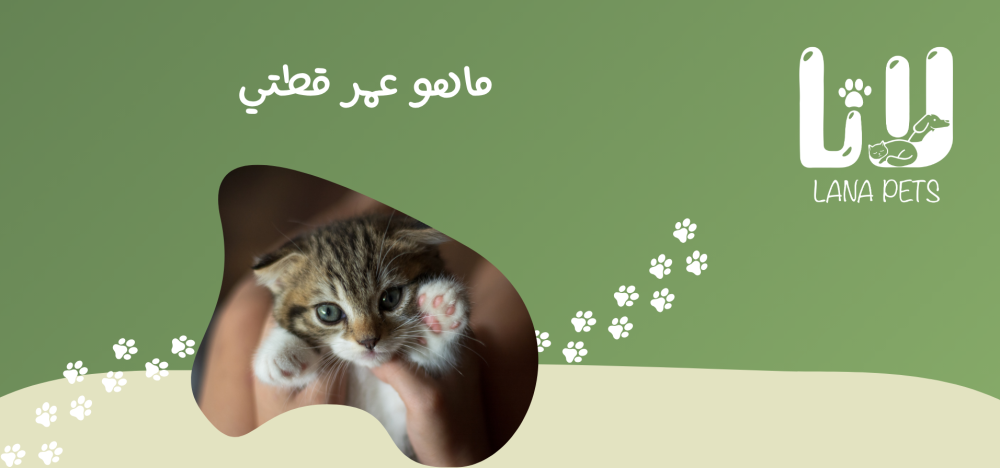
Cat age and how to accurately calculate your cat's age. As a new breeder, this may be one of the first questions that come to your mind when adopting or rescuing a cat. Knowing your cat's age helps you in some matters related to raising it, such as when can it mate? Or choosing products suitable for its age from the Panda store.
Calculating the age of cats requires some simple and precise steps. Cats develop quickly and show specific signs that help you know their age. Therefore, in this article, we will explain how to calculate your cat’s age step by step.
How to calculate your cat's age?
The exact age of cats cannot be known even by a veterinarian, but it is usually approximate, and is determined by:
Dental check:
The primary baby teeth appear between 2 and 4 weeks of age, making them an excellent indicator of age in kittens. Permanent teeth begin to grow over the baby teeth between 3 and 4 months, and all permanent teeth are usually in place by 6 months of age or older. In older cats, the amount of staining or tartar on the teeth can be an indicator of age: by the age of 2, teeth usually lose their luster, and by the age of 3-5, tartar may build up around the gum line and show tooth erosion. However, the availability of Pet dental cleaning products may affect this indicator, so although teeth are a good indicator of a cat's approximate age, they are not foolproof.
Sexual maturity:
If the cats are not neutered, their age can be calculated by sexual maturity; males reach sexual maturity at 6-9 months of age, and the male begins to spray urine and meow, and the testicles are more visible below the anus.
As for females, they go through their first estrus period at 5-9 months, and symptoms appear such as the sound of cats mating, rolling on the ground, and trying to escape to search for male cats. The estrus period is affected by several factors, including the weight of the cat and the length of the day.
However, sterilization is usually done at 4 months of age, especially in adopted cats, so this indicator becomes unimportant in this case.
Fur condition:
Cats' fur is soft when they are young, but it becomes thicker and rougher as they get older, usually between 6 and 12 months of age. As they age, the color of the fur changes to become darker or lighter, and patches of white or gray hair appear. Although the condition of the fur is not an accurate guarantee of age, it can help you estimate the age of your cat.
Cat eyes:
Healthy cats in their early years have clear, bright eyes without any tearing or discharge. As they age, cats over ten years old may begin to develop a cloudy appearance in their eyes, with tears or discharge.
Determining the age of kittens
The focus is usually on determining the age of kittens, especially in the case of cat rescue. It can be determined in the following ways:
the weight:
This scale is not an accurate way to determine your cat's age; weight can vary depending on breed, health, and growth conditions. However, breeders usually find it an easy and approximate way. The cat's weight is as follows:
- Newborn: about 0.1 kg.
- Week 1-2: 0.11-0.17 kg.
- Week 2-3: 0.17-0.23 kg.
- Week 4-5: 0.23-0.45 kg.
- Week 6-7: 0.45-0.68 kg.
- Week 7-8: 0.68-0.9 kg.
After that, weight increases at an approximate rate of 0.45 kg per month in large cats, until the adult cat reaches a weight of about 4.5-5 kg.
Teeth:
Teeth are an effective and more accurate way to determine a cat's age, especially in the first weeks of life. They are determined as follows:
- No teeth: could be less than 2 weeks old.
- Incisors: They begin to appear between the second and fourth weeks.
- Fangs: appear between the third and fourth weeks.
- Molars (molars): appear between the fourth and sixth week.
- Molars: They do not appear until about 16 weeks of age.
A kitten's baby teeth usually consist of 26 teeth, and they begin to change to permanent teeth starting at the age of 4 months, and complete the change between 4-7 months, and their number reaches 30. Therefore, after the age of 6 weeks, the number of teeth becomes less accurate in determining the age of cats, which requires relying on other methods.
Other ways:
In determining the age of cats, it is preferable to use one or more methods with the cat dental guide to determine age. These methods include:
- Eyes: The eyes open between 7-10 days, are blue at birth, and begin to change color at 7 weeks.
- Ears: They remain folded until about 7 days of age, and begin to open gradually in the second week after birth.
- Umbilical cord: It falls off within the first week. If it is present, the kitten is less than 5 days old.
- Fur: Kittens' soft fur begins to become thicker and coarser as they age, and they begin to shed their adult fur at 6 months of age.
- /li>
Now that you know the age of your cat, if you find it difficult, you can ask Lana Veterinary Clinic to help you do this in a more professional way. However, in any case, we advise you to know the approximate age of your cat to choose the appropriate products from Lana Pets Store.

